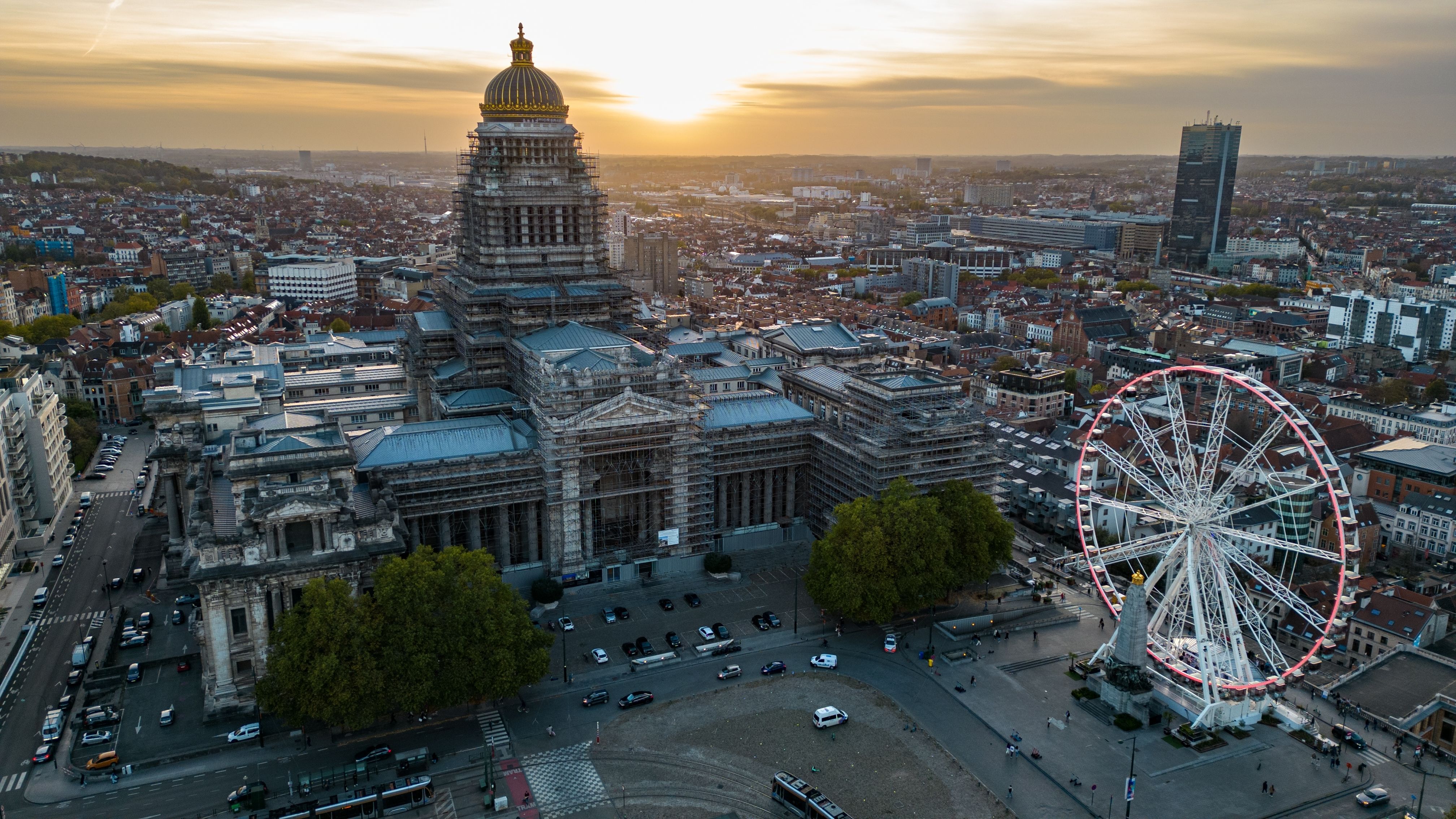Metamorphosis of Brussels Palace of Justice can finally begin
The Brussels Region has issued the planning permit for the facade restoration and lighting of the Palace of Justice.
Brussels State Secretary for Urbanism and Heritage, Pascal Smet, and State Secretary for the Federal Buildings Authority, Mathieu Michel, confirm that another important step has been taken to restore the facades of the Brussels Justice Palace and to embellish it with night lighting. Through urban.brussels, the Brussels Region has granted the planning permit for the first phase of the overall restoration of the facade. This includes the restoration of the front facade of this listed building, at Place Poelaert, the lighting of the facades, adaptations to the main courtyard and the installation of an ornamental fence to secure access to the building.
“The first scaffolding was installed almost 40 years ago, there were reflections on the purpose of the Palace of Justice, numerous historical and architectural studies and diagnoses, and a competition was organised. Now, this planning permit for the facade restoration finally seals the restoration of this emblematic building. This means its role as the central hub of Justice in our capital will be preserved. The Palace of Justice is an eclectic architectural gem from the 19th century and is so monumental that it is unique European heritage. It will finally regain its original glory and once again shine as the roof of Brussels. With this restoration, the federal and regional authorities are putting an end to a disgraceful situation that has lasted for too long. This symbol of our national heritage will finally once again become a showcase of our city and of Belgium,” declared Pascal Smet, Brussels State Secretary for Urbanism and Heritage.
"The Brussels Palace of Justice is one of the most important and emblematic buildings in the capital and in Belgium, and houses the highest court in our country. Its historical and architectural dimension means that its preservation and renovation are crucial for cultural and heritage reasons. From the beginning of my mandate, I identified its restoration as a priority as Secretary of State in charge of the Building Administration.. Today, the Building Administration has received planning permission for the first phase of the restoration of the facades. We are thus taking another important step towards a courthouse without scaffolding, and this within the planned timeframe. Everyone knows that it takes a long time to ensure that all visitors to Brussels can admire the Palais de Justice. It is also a job that involves overcoming various obstacles. Today we are taking another step forward in this titanic work. Tomorrow, I will continue the work so that the Palais de Justice will be completely free of scaffolding by 2030, the year Belgium celebrates its 200th anniversary."declared Mathieu Michel, Belgian State Secretary for la Regie des Bâtiments.
Specifically, the planning permit covers various works on the facades, primarily through the restoration of the stone cladding. The various analyses indicated that the stones, especially the Comblanchien ones, suffer conservation problems at various levels. Sampling confirmed this. Using the criteria of the Royal Institute for Cultural Heritage, the amount of facade stone cladding to be replaced was been drastically reduced thanks to additional inspections and relying on preventive conservation measures and regular maintenance to be taken in the future. To be clear, the aim of the heritage work is to preserve or restore the existing stonework to its maximum extent.
Finally, the permit includes the integral restoration and repainting of the various joineries. A detailed inventory of all the joinery has been drawn up, categorising it according to the various requirements (historical value, safety, climate, structure and materials, glass, locks and hinges, etc.). With one exception (a door to be replaced), the windows and doors are in good condition and will all be preserved and restored, with specific repairs. As far as glazing is concerned, the work will integrate various new types of it, including security glazing and anti-intrusion in sensitive areas and insulating glass in heated rooms.
To better secure the Palace of Justice and to limit the entrances, a new fence will be installed. It will be directly inspired by the historical fence that has disappeared today and will be placed on the Palace’s forecourt. This new fence has been approved by the Brussels heritage committee “Commission royale des Monuments et des Sites” and will respect the aesthetics and heritage dimension of the site, in accordance with the conservation decree.
The restoration project will be completed with redevelopment works of the courtyard, which will primarily address waterproofing issues, secure the surroundings of the Palace and install stair railings. All developments will comply with the compositional elements of the implementation plans, while the stones recovered during the various works planned, will be reused.
In the context of the development of public spaces on the forecourt, the permit specifically requires the City of Brussels to be involved in monitoring the works and various interventions. Indeed, it is essential that the planned developments are part of an overall reflection on the future of Place Poelaert, ensuring its uniformity and preserving the architectural composition that contributes to the cityscape.
Finally, carefully designed lighting has been planned as part of the restoration works. This scenographic lighting is fully in line with the regional lighting plan, adopted in 2017 by the Brussels government. It aims to highlight the architectural and aesthetic characteristics of the Palace of Justice and to reveal its monumentality in the Brussels skyline once night falls. While the lighting will enhance certain characteristic elements of the building, it will remain sober and harmonious and will be gradually adjusted throughout the night.




